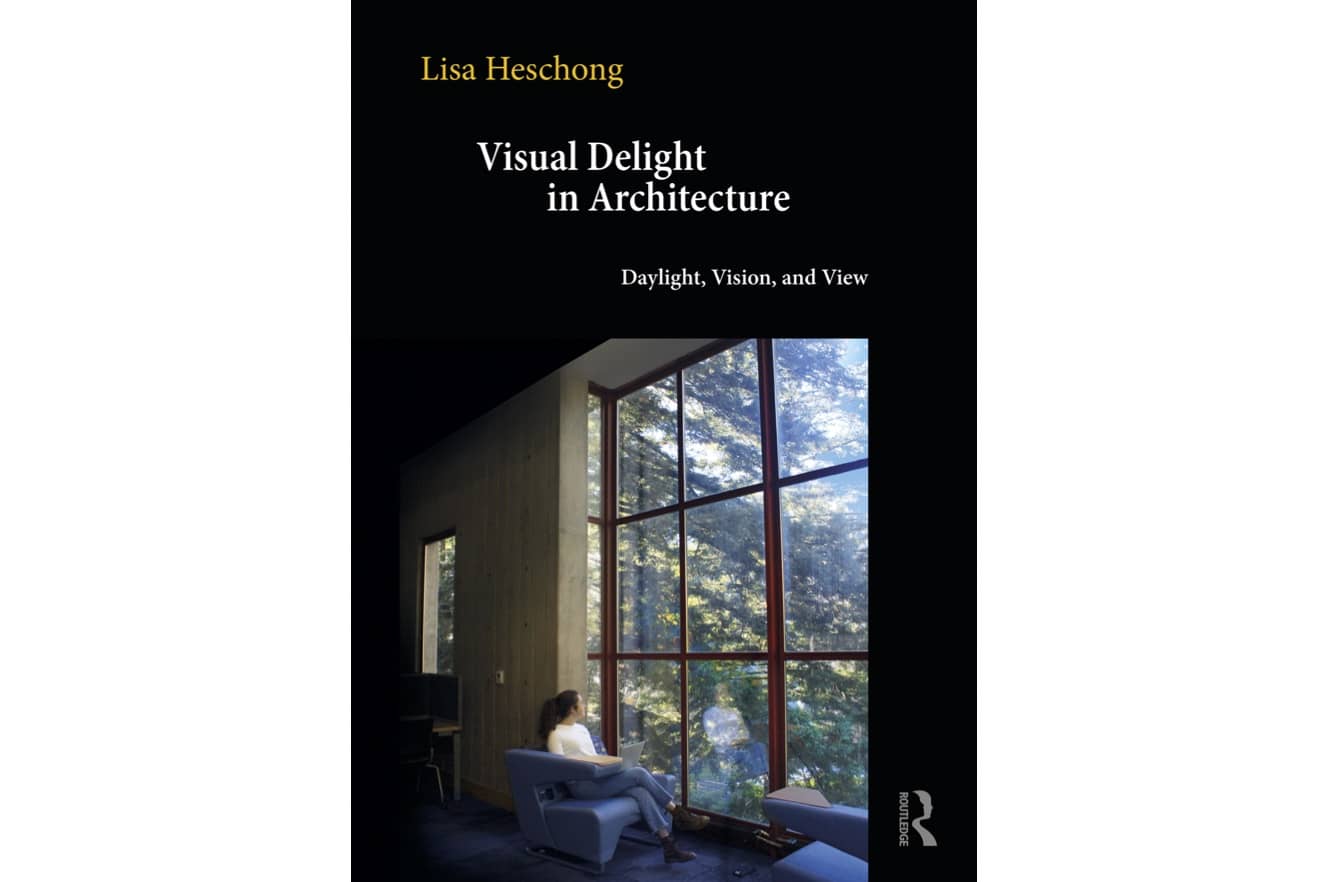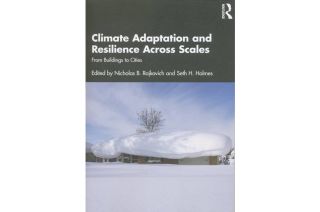
www.buildingsandcities.org/insights/reviews/visual-delight-architecture-daylight.html
Visual Delight in Architecture: Daylight, Vision and View

by Lisa Heschong. Routledge, 2021. ISBN 9780367563233
Christopher Meek (Center for Integrated Design, University of Washington) reviews this important book which makes a strong, clear case for the provision of daylight and views in our buildings and cities.
Lisa Heschong's recent book is an expansive journey through her extraordinary career's worth of ideas centered around the human need for light, specifically the dynamism of daylight and the role of views as grounding our place in the world. Its emphasis is on the critical importance of bringing that experience into buildings. Written in the style of books such as Michael Pollan's The Omnivore's Dilemma, it blends peer-reviewed research with an accessible style, detailed personal anecdotes, and informed-speculation to tie together expansive themes of science, architecture, medicine, and the experience of being in buildings. Visual Delight catalogs the interconnected arguments for a robust indoor visual environment fundamentally shaped by the stimulus of ever-changing daylight and prospect of our surrounding landscape of nature and human activity. Its wide scope spans a range of topics from what makes for a memorable space to prescriptions for future cities and a warning about the seductions of 'virtual' realities aimed at displacing authentic human experience.
Heschong may be most well-known (at least to architecture students) for Thermal Delight in Architecture: a call-to-arms which advocates for the recapture of the cultural and experiential magic of the thermal sensory environment. This successfully argued against the 'thermal beige' of mechanically heated and air-conditioned buildings with narrowly prescribed temperature variation regardless of context or season. Her career, briefly as an architect, and then as an independent researcher has been a quest to understand why daylight and views are so compelling, and to promote their presence as a fundamental starting point for the design and experience of buildings.
Heschong's professional and research work has been influential in the design of offices, the impact of daylight on retail sales, the pursuit of energy efficiency, the quantification of view quality, and building user satisfaction, though arguably her greatest impact has been on the design of school buildings. Her work has established links between the presence and quality of daylight and views in classrooms with student learning outcomes. She tells the story behind the influential series of interconnected epidemiological studies that established a strong statistical connection between student learning outcomes and the presence of daylight and views in classrooms. This has influenced a generation of schools and classroom designers.
As a comprehensive weaving of the threads of her work, Visual Delight takes the reader on a journey explaining how daylight, views, and the visual environment intersect with health, human performance, and the experience of buildings. Early on, Heschong confronts the challenge faced by both researchers and practitioners seeking to connect building design ideas with beneficial experiential and health outcomes. She asks for 'patience' from readers who may be unaccustomed to jargon associated with neurological scientific terminology, and similarly asks for the forbearance of researchers who may be uncomfortable with her speculation about the implications of their work. She describes her approach to connecting narrowly defined medical research and the applications of that knowledge in building design:
As an architect, trying to understand cognitive science is like playing the child's game of 'connect the dots' except the dots that outline the picture are not yet numbered and many of them are still missing.
Visual Delight makes the argument for daylight as a necessary ingredient for thriving in our indoor experience of the world. Her case is well-constructed, breaking down the aspects of daylight and view into core questions (e.g. what makes for an interesting view?) while summarizing the best research in accessible language, and speculating on how findings could be translated into building design, policy, and quantitative metrics. The book is structured into four sections: Prediction, Perception, Motivation, and Meaning. It begins at the cosmic scale, outlining the planetary rhythms that shape the luminous experience of night, day, and the seasons. The experience of light on earth is followed by a deep yet accessible dive into science of the human eye, perception and environmental stimulus, and the circadian rhythm: the light-dark cycle that regulates brain chemistry, mood, and human physiology. Heschong outlines recent discoveries in biological science. These range from the discovery of organs within the brain (intrinsically photosensitive retinal ganglion cells) that connect the experience of (and preference for) daylight directly to systems of circadian regulation. Another highly relevant scientific finding is how momentary glances to a view of the outdoors help to maintain concentration and cognition.
Departing from the physiological imperatives of daylight, Heschong delves into the more qualitative aspects of daylight and view. She proposes a vocabulary of daylight experiences that nods to the framework of the mid-20th century electric lighting designer Richard Kelly (ambient luminescence, focal glow, and play of brilliants). This provides readers with an analogous palette of daylight phenomena for building interiors: sunlight and daylight, shadow, sparkle, and glare. These become the basis for design interventions by buildings designers and owners. Heschong gives the reader strategies and tactical guides to deliver these aims.
This book also provides a cultural and technological history of building design trends. Late 19th century buildings were designed with daylight out of necessity. The advent of electric lighting gave architects the freedom to shape buildings unconstrained by the limitations of daylight as a primary source of illumination (placing people far from windows and skylights). More recently, there has been a revaluation of daylight and view through the paradigm of energy efficiency, sustainable design, and more recently circadian entrainment. This transformation is elaborated through the morphological evolution of the school classroom (from fundamentally daylit, to designating windows as a liability, and then a return to the use of daylight as a primary source of illumination).
A significant challenge for the research community is to support evidence-based design in the built environment. Heschong proposes a 'three-legged stool' of clinical work (post-occupancy evaluation of occupied buildings), epidemiological studies (looking at population-level outcomes), and conventional laboratory research. Heschong argues that only a cross-disciplinary view will provide designers and policymakers with sufficient perspective to fully realize the value of environmental design attributes such as daylight and views.
As a counterpoint to empirical evidence, vignettes are used to bring the big ideas of Visual Delight down to the scale of the individual building user experience. Drawn from observations of office workers, warehouse workers, the self-designed famous writer's cabin, these anecdotes highlight why the passage of time and seasons in our cities is crucial to our ability to thrive. Particularly compelling are the stories of long-term health care settings where patients, unable to easily experience the outdoors suffer disorientation and significant sleep disruption due to lack of daylight exposure. In a particularly poignant personal recollection, Heschong shares her brother's experience in hospice care: a view of a tree provided solace and a connection to the earth. This had profound importance and meaning during the last days of his life.
This book makes a positive argument for the inclusion of daylight and views in buildings because of the environmental stimulation these elements can provide for health, well-being, and productivity. However, it also offers a warning for those who seek to emulate aspects of light and view through synthetic technological means. Bolstered by the work of Peter Kahn and others who decry the diminishing presence of 'nature' in each successive generation's experience of the world, Heschong asks whether such efforts become a placebo for the authentic experience of living on earth, ultimately devaluing the fundamental nature of human experience.
A compelling case is made for daylight and views as a human right for building occupants. Heschong offers prescriptions for reclaiming and protecting the 'right to light'. In the face of increasing density and a digitally mediated world, building design and city planning can connect occupants to nature and provide access to daylight. Possible regulatory mandates are suggested, based on international examples.
Visual Delight is a must-read for building designers and others interested in gaining a better understanding of daylighting in buildings and for those interested in biophilia. A casual reader will appreciate the insights into the use of daylight and views and their impact on building occupants. Architects will benefit from the prescription and critique of their profession. Researchers will benefit from the questions posed about the beneficial role of light in human health and in buildings. Design strategy sections are concise and informative, but the reward of this book is on the philosophical musings, the anecdotes, and the speculation and insights that link daylight, views, and individual or social outcomes. This book inspires the reader to make new connections.
Latest Peer-Reviewed Journal Content
Designing for pro-environmental behaviour change: the aspiration–reality gap
J Simpson & J Uttley
Lifetimes of demolished buildings in US and European cities
J Berglund-Brown, I Dobie, J Hewitt, C De Wolf & J Ochsendorf
Expanding the framework of urban living labs using grassroots methods
T Ahmed, I Delsante & L Migliavacca
Youth engagement in urban living labs: tools, methods and pedagogies
N Charalambous, C Panayi, C Mady, T Augustinčić & D Berc
Co-creating urban transformation: a stakeholder analysis for Germany’s heat transition
P Heger, C Bieber, M Hendawy & A Shooshtari
Placemaking living lab: creating resilient social and spatial infrastructures
M Dodd, N Madabhushi & R Lees
Church pipe organs: historical tuning records as indoor environmental evidence
B Bingley, A Knight & Y Xing
A framework for 1.5°C-aligned GHG budgets in architecture
G Betti, I Spaar, D Bachmann, A Jerosch-Herold, E Kühner, R Yang, K Avhad & S Sinning
Net zero retrofit of the building stock [editorial]
D Godoy-Shimizu & P Steadman
Co-learning in living labs: nurturing civic agency and resilience
A Belfield
The importance of multi-roles and code-switching in living labs
H Noller & A Tarik
Researchers’ shifting roles in living labs for knowledge co-production
C-C Dobre & G Faldi
Increasing civic resilience in urban living labs: city authorities’ roles
E Alatalo, M Laine & M Kyrönviita
Co-curation as civic practice in community engagement
Z Li, M Sunikka-Blank, R Purohit & F Samuel
Preserving buildings: emission reductions from circular economy strategies in Austria
N Alaux, V Kulmer, J Vogel & A Passer
Urban living labs: relationality between institutions and local circularity
P Palo, M Adelfio, J Lundin & E Brandão
Living labs: epistemic modelling, temporariness and land value
J Clossick, T Khonsari & U Steven
Co-creating interventions to prevent mosquito-borne disease transmission in hospitals
O Sloan Wood, E Lupenza, D M Agnello, J B Knudsen, M Msellem, K L Schiøler & F Saleh
Circularity at the neighbourhood scale: co-creative living lab lessons
J Honsa, A Versele, T Van de Kerckhove & C Piccardo
Positive energy districts and energy communities: how living labs create value
E Malakhatka, O Shafqat, A Sandoff & L Thuvander
Built environment governance and professionalism: the end of laissez-faire (again)
S Foxell
Co-creating justice in housing energy transitions through energy living labs
D Ricci, C Leiwakabessy, S van Wieringen, P de Koning & T Konstantinou
HVAC characterisation of existing Canadian buildings for decarbonisation retrofit identification
J Adebisi & J J McArthur
Simulation and the building performance gap [editorial]
M Donn
Developing criteria for effective building-sector commitments in nationally determined contributions
P Graham, K McFarlane & M Taheri
Join Our Community

The most important part of any journal is our people – readers, authors, reviewers, editorial board members and editors. You are cordially invited to join our community by joining our mailing list. We send out occasional emails about the journal – calls for papers, special issues, events and more.
We will not share your email with third parties. Read more



Latest Commentaries
COP30 Report
Matti Kuittinen (Aalto University) reflects on his experience of attending the 2025 UN Conference of the Parties in Belém, Brazil. The roadmaps and commitments failed to deliver the objectives of the 2025 Paris Agreement. However, 2 countries - Japan and Senegal - announced they are creating roadmaps to decarbonise their buildings. An international group of government ministers put housing on the agenda - specifying the need for reduced carbon and energy use along with affordability, quality and climate resilience.
Building-Related Research: New Context, New Challenges
Raymond J. Cole (University of British Columbia) reflects on the key challenges raised in the 34 commissioned essays for Buildings & Cities 5th anniversary. Not only are key research issues identified, but the consequences of changing contexts for conducting research and tailoring its influence on society are highlighted as key areas of action.